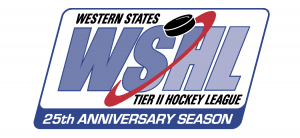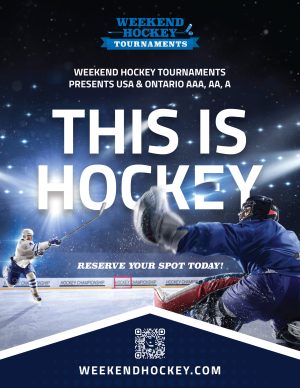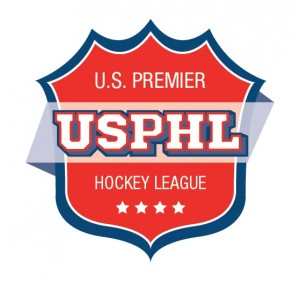Now in its 25th season as a junior hockey league, WSHL has stood the test of time

Dr. Don Thorne is a Vietnam veteran, but he didn’t teach his son to shoot guns.
He taught his son to shoot pucks.
To the rest of the country, hockey across the Sun Belt has always been an unfathomable concept. Ideas of the sport taking the Southwestern United States by storm were almost fictional constructs. But to Dr. Thorne, it was the perfect zone to embark on a journey known as the Western States Hockey League (WSHL).
“I wanted to have a program that people did not have to leave the state for their kids to play in a competitive junior program,” Thorne said. “I’m very proud of what it is today, and I try to acknowledge that every time I hand out the (Thorne) Cup.”
It was right around the same time that a particular NHL player was making a splash throughout the West. The ripples grew to increase the popularity of hockey and brought it to new heights in the region.
“At the time that Don formed the league, hockey in California was going through one of those transitional periods,” WSHL commissioner Ron White said. “Going from a little-known sport to a more active Wayne Gretzky era, Don wanted a junior travel league that his son could play in so he put it together.”
As the sole financial backer of the league and teams, Thorne’s original six saw fresh sheets of ice for the 1993-94 season. The original six comprised of the Anaheim Jr. Ducks, Arizona Bandits, Las Vegas Jr. Aces, San Jose Jr. Sharks, Utah Lightning and the Ventura Mariners.
Under the guise of putting this project together for his son, Thorne established the first junior hockey league in the Western United States. By the 1995-96 season, his son had aged out and the tremors of solely running a hockey league were starting to catch up. Fast-forward to 1998 and the league had expanded to over a dozen teams.
White’s play in the overall evolution of the league was monumental being that he was well-established with USA Hockey as the coach-in-chief of the Pacific District. League management, prior to White’s involvement, was lacking hockey expertise and the geographical structure proved to be counterintuitive. He first began as CEO of the Anaheim Jr. Ducks – now the Long Beach Bombers – before taking on more responsibility.
“The league started to become an overall distraction in his Don’s life and financially, so he asked me to become commissioner,” White said. “He had engaged with groups as far north as Alaska that were all part of the WSHL at one point. When you had to travel to Fairbanks to play a weekend’s worth of games, it was a huge cost to your annual budget. So we released the teams in the Northern Division, which many became founding members in the NORPAC, and any problematic owners in the Southern Division.”
 California, Nevada and Arizona encompassed the foundation before Dallas and Tulsa started new growth in the WSHL footprint. The WSHL operated as a Junior B league and eventually entered the Junior A level in 2007. White sought for more competitiveness and an increase in skill with league membership gaining steam and a major turning point in league history was looming.
California, Nevada and Arizona encompassed the foundation before Dallas and Tulsa started new growth in the WSHL footprint. The WSHL operated as a Junior B league and eventually entered the Junior A level in 2007. White sought for more competitiveness and an increase in skill with league membership gaining steam and a major turning point in league history was looming.
Cutting down travel distance was priority as was cutting down annual travel budgets, therefore, teams needed to be added.
“Since we changed our operating and recruiting rules, we have seen a dramatic increase in the development of skill every year in the WSHL,” White said. “We needed to get to where we are today with divisions that are self sustaining in play.”
The WSHL took steps forward, joining the Amateur Athletic Union (AAU) and operated under the United Hockey Union (UHU) that was formed to oversee a few junior leagues, including the WSHL.
Executive committee member and Dallas Snipers owner Steve Becton saw this as a fortuitous next step.
“It didn’t hurt us in any way,” Becton said. “It gave us, as a league, a better opportunity to market against other North American junior hockey leagues. We were able to position ourselves closer in competition.”
Measuring success is key for any venture regardless of the size. The WSHL began to turn heads and make its presence felt as far as the East. The East Coast powerhouse hockey programs claimed the sport, which largely overshadowed the WSHL.
A weekend of exhibition hockey in South Lake Tahoe blazed the trail for further exposure to dispel any misconceptions of hockey in the West.
“From the time that I joined back in 2002-03, the league was not nearly what it is today,” WSHL deputy commissioner Bob Armando said. “This is a big and powerful junior hockey league.”
That weekend of friendly hockey at Lake Arrowhead became to be known as the Western States Shootout. Armando credits the now annual showcase as the method of measuring success. After all, getting players to the next level is the mantra of the league.
As many as 500-600 WSHL players gather every year for the annual showcase that is now going on 18 years. Since South Lake Tahoe in the early days, the showcase has been held in San Antonio and then moved to its current city of Las Vegas. The showcase went from being in a non-scout environment to over 100 in attendance. This month will be the second year at City National Arena, official practice facility of the NHL’s Vegas Golden Knights.
“I already sent out an initial batch of invitations to college scouts,” Armando said. “Hockey season hadn’t even started for many programs and I already had 50 confirmations from quality hockey schools that want to attend the showcase. Last year, we ended up with probably 135 colleges that showed up to see our kids and this year, we expect to exceed that number.”
It is at the showcase that many skaters get the chance to impress the eyes that want to help their ascension of the hockey ladder. And that is a phenomenal accomplishment going from a product that rarely enticed to a date that institutions circle on their calendar.
“Through Ron’s guidance, we got stronger,” Armando said. “We hired great coaches to start developing players and by doing so, your identity changes. Then, you are able to attract attention from where we are trying to place these kids, which is in Midwest- and East Coast-oriented programs that are starting to turn West.”
Similarly, the Valencia Flyers, an 18-year member of the league, and owner Roger Perez declare that the quality and effectiveness of the league to fulfill its promise of player development is a sincere satisfaction.
“To be able to see the product now compared to what it was 20 years ago, it’s a great success,” Perez said. “Players are getting to go to top colleges and are recognizing their objectives in life through this league.”
The feeling of accomplishment lingers with the more seasoned partners. The hard work and determination to battle against hurdles eased the league’s transition to a more recognizable entity.
“I’m happy to be a part of this achievement and to help in the presentation of the league,” Perez said. “Now, you see players are able to impress coaches and scouts that see them. It’s a testament to the work put in by all the partners.”
Hockey, like every other sport, requires diligent officiating. WSHL director of officials Arthur Kitano has been with the league since it began 25 years ago. Kitano initially started as an on-ice official and has seen the style of play in the WSHL evolve directly from the ice.
“Over the years, the league has taken giant leaps and bounds to have more of a skill-based type of play,” Kitano said. “It’s also the natural progression of the sport, moving from the 1990’s tug-and-grab to a more wide-open style of game.”
Team partners in the last six years have been able to continually attract high-quality players from Europe, Canada and the United States. The consistent influx has elevated the game to where it is now. More importantly, the opportunity to play junior hockey has been instilled in a region that never was given the chance.
“The league has done wonders to give the opportunity for hundreds of kids to play ice hockey after the age of 18,” Kitano said. “My biggest satisfaction has been seeing the growth and popularity of the league over the last 25 years.”
The WSHL placed a big footprint in its Western region, but the expansion did not end there.
This is now an international league with its branches stretching into the Canadian provinces of Alberta and Saskatchewan. The Edson Aeros, Cold Lake Wings, Meadow Lake Mustangs and Hinton Wild Cats joined the WSHL this year.
“This is definitely a great first starting point,” WPHA director of international expansion Derek Prue said. “Our potential footprint there is quite large.”
Hockey and Canada go hand in hand – this is a given. With friction between Alberta and Saskatchewan, the feasibility of exciting natural rivalries can already be foreseen. These rivalries reward communities with a sense of pride for their cities. More so, they are answering to the ever-abundant demand of junior hockey in that part of Canada.
“There’s a lot of kids in Western Canada that leave home every year to play at various junior hockey leagues,” Prue said. “There simply aren’t enough teams out here for high-level players, so this was certainly on the demand side and market side. After talking to various communities, the WSHL seemed like the obvious choice.”
“Any time that we can get a stronger footprint, whether it be through various geographies in the United States, it’s good for North American junior hockey,” Becton added. “When we moved into Canada, we are now advertising there that we are a strong junior league.”
The presence of the WSHL in Canada facilitates the desire for more kids, but also embraces the possibility of being a strong avenue for those seeking U.S. colleges.
Today, the league honors the regular-season champion with the Thorne Cup to remember that first puck drop – the first pebbles in place by Dr. Thorne – all those years ago.
Photos/Mark Mauno
— Manny Brizuela
(Dec. 7, 2018)










